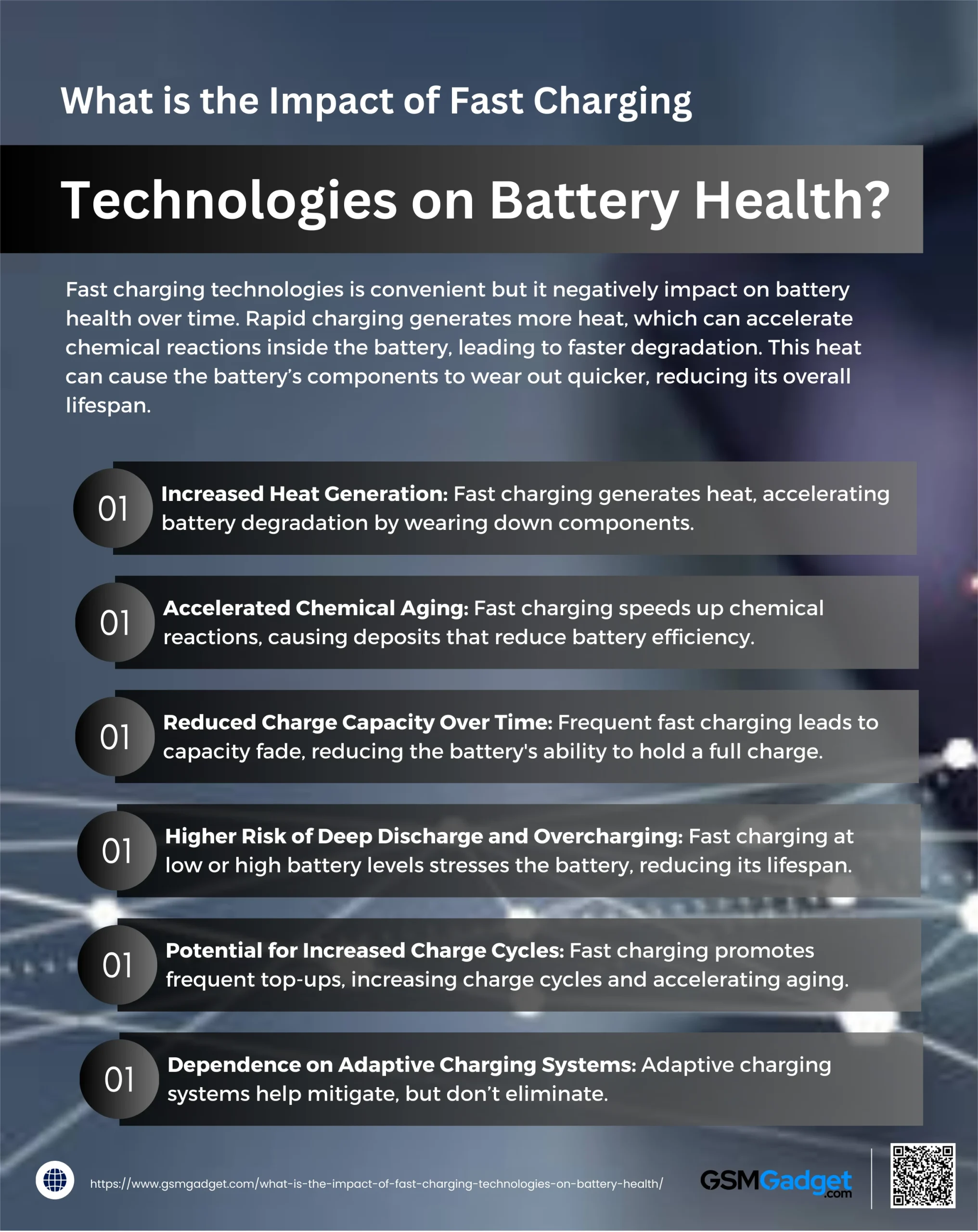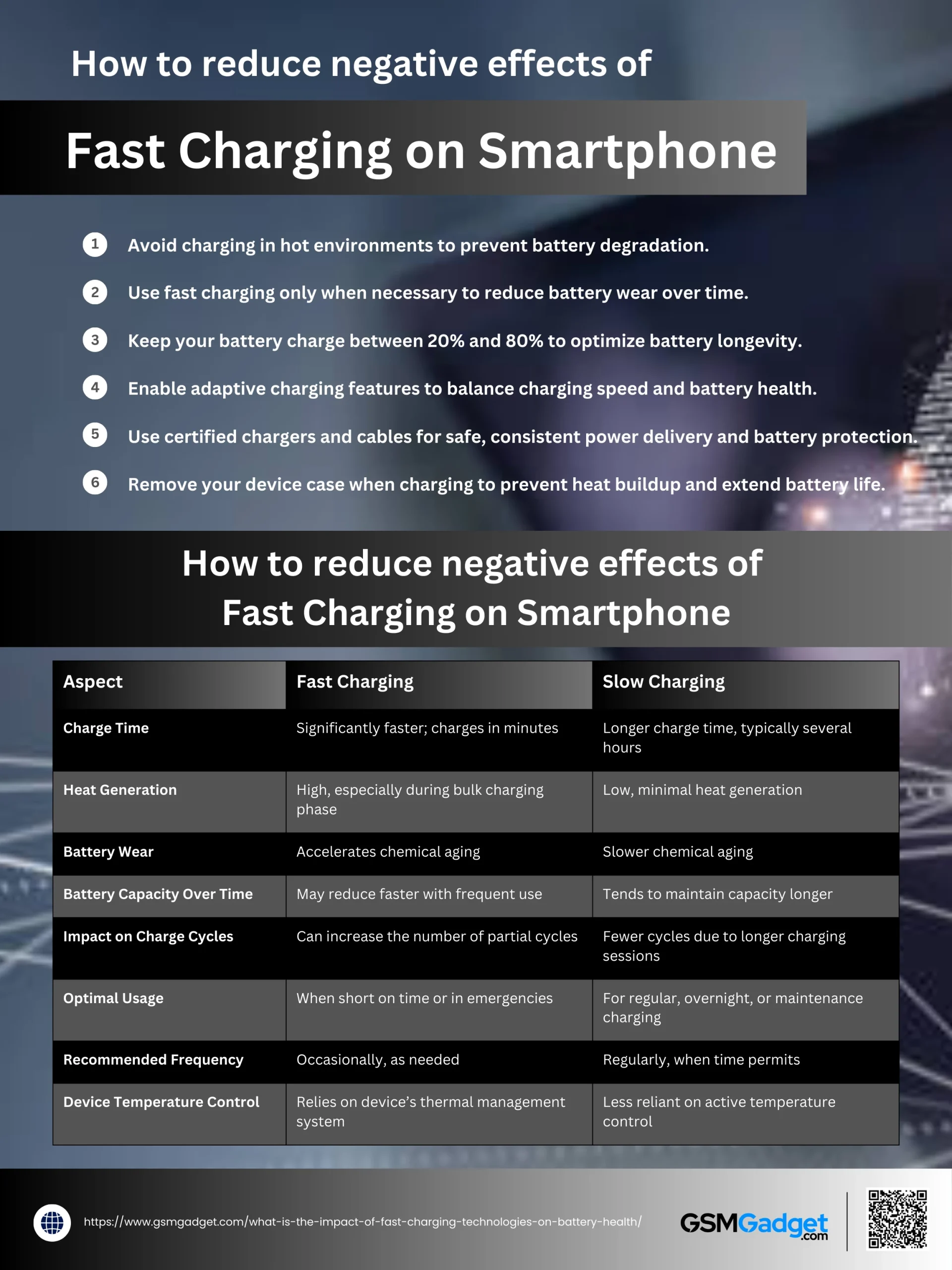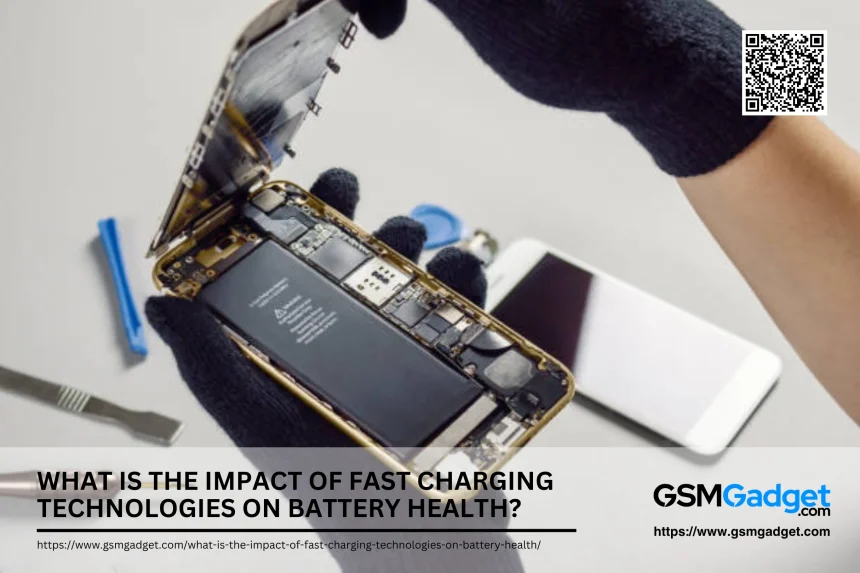Fast charging technologies is convenient but it negatively impact on battery health over time. Rapid charging generates more heat, which can accelerate chemical reactions inside the battery, leading to faster degradation. This heat can cause the battery’s components to wear out quicker, reducing its overall lifespan. Additionally, high charging currents may stress the battery’s structure, particularly if it lacks advanced cooling or protection mechanisms. Over time, repeated use of fast charging may result in reduced battery capacity, causing it to hold less charge and requiring more frequent recharges. However, many manufacturers incorporate safeguards to minimize these effects, such as temperature monitoring and power management, which help mitigate potential harm.
Here’s a closer look at how fast charging affects battery health:
1. Increased Heat Generation
Fast charging operates by delivering high power to the battery in a short period, which generates heat as a byproduct. Heat is one of the main factors that accelerate battery degradation because it causes chemical reactions that wear down battery components. Although modern devices are equipped with thermal management systems to monitor and moderate temperature, frequent exposure to high heat can still affect a battery’s internal structure. Over time, this heat can reduce the battery’s capacity, limiting how long it can hold a charge. Maintaining moderate temperatures while charging can help mitigate some of these effects.
2. Accelerated Chemical Aging
Batteries rely on controlled chemical reactions to store and release energy. When a device is fast-charged, the high voltage and current speed up these chemical reactions, creating additional wear on the battery’s internal chemistry. This can result in the accumulation of unwanted deposits on the battery’s electrodes, known as chemical aging. As these deposits increase, they reduce the battery’s ability to transfer energy efficiently, leading to a decline in capacity and performance. While adaptive charging systems help manage this aging, they may not fully offset the accelerated wear from fast charging.
3. Reduced Charge Capacity Over Time
Batteries subjected to frequent fast charging cycles can lose their ability to reach or maintain a full charge. This effect, known as capacity fade, means the battery’s maximum capacity diminishes over time. For example, a device that initially lasts a full day on a single charge might start requiring multiple charges throughout the day. This decline in charge capacity is often more noticeable when fast charging is consistently used over traditional, slower charging methods. Balancing fast charging with regular charging can help maintain capacity for a longer period.
4. Potential for Increased Charge Cycles
Fast charging encourages frequent top-ups, which can lead to a greater number of charge cycles. A charge cycle occurs when a battery is fully discharged and then recharged, and every battery has a finite number of these cycles before it starts to degrade. Even though a single fast charge may not count as a full cycle, frequent partial charges can add up, accelerating the battery’s aging process. Using fast charging only when necessary and allowing for fuller, slower charges when time allows can help reduce the total number of charge cycles over time.
5. Higher Risk of Deep Discharge and Overcharging
Fast charging is often used when devices are critically low on power or need a quick top-up to full charge, both of which can strain the battery. Deep discharges, where the battery level is very low before charging, put stress on the battery, especially if done frequently. Similarly, reaching 100% with fast charging can be hard on battery health. Experts recommend keeping your battery level between 20% and 80% to reduce stress on the battery and help maintain its capacity over time.
6. Dependence on Adaptive Charging Systems
Many modern devices have adaptive charging systems designed to monitor temperature, charge levels, and battery health to optimize the charging process. These systems are helpful in managing some of the stress associated with fast charging by slowing the charge rate as the battery nears full capacity or as it heats up. However, while these protections reduce the immediate impact, they may not eliminate long-term effects on battery health from frequent fast charging. Relying solely on adaptive charging features without moderating your charging habits could still lead to gradual degradation, so using fast charging when it’s necessary rather than constantly is a smart approach.
 What is Fast Charging?
What is Fast Charging?
Fast charging is a technology that enables mobile devices to recharge their batteries at a significantly accelerated rate compared to standard charging methods. By increasing the power delivered to the device, either through higher voltage, increased current, or both, fast charging reduces the time required to reach a full charge.
How to reduce negative effects of Fast Charging on Smartphone
Here are some practical strategies for minimizing the impact of fast charging:
1. Avoid Charging on Hot Environment
Charging in high temperatures increases the risk of battery degradation, as heat accelerates chemical reactions within the battery that can break down its components. Fast charging already generates more heat than standard charging, so charging your device in hot conditions, such as direct sunlight or a hot car, can exacerbate this effect. Similarly, extremely cold conditions can impact the battery’s efficiency and longevity. Charging your device in a moderate temperature range, ideally between 20°C and 25°C (68°F to 77°F), helps reduce stress on the battery. Additionally, avoid using your device for power-intensive tasks, like gaming or streaming, during fast charging, as this can increase heat further.
2. Use Fast Charging only when It’s truly needed
Frequent fast charging can put more wear on your battery over time due to increased heat and faster charge cycles. While it’s fine to use fast charging when you’re pressed for time or need a quick power boost, consider using slower, regular charging methods for everyday use or overnight charging. Slower charging is gentler on the battery, generating less heat and reducing the frequency of partial charge cycles, which can extend battery health in the long term. Balancing between fast and slow charging methods helps you enjoy the convenience of fast charging without relying on it constantly.
3. Keep Battery Between 20% and 80%
Allowing your battery to charge fully from a very low level (e.g., under 10%) or letting it drain completely before recharging can strain the battery’s internal components. Studies suggest that keeping your battery level within a moderate range—between 20% and 80%—is optimal for battery longevity. Charging within this range reduces the stress of deep discharges and overcharging, which are known to accelerate battery wear. When possible, try to avoid starting fast charging from an extremely low battery level or charging to 100%, as these conditions can put additional strain on the battery.
4. Enable Adaptive Charging Features
Many modern devices come with adaptive charging technologies designed to optimize battery health by adjusting the charge rate based on various factors, such as temperature, battery health, and charge level. These features may slow down the charging rate when the battery nears full capacity or during longer charging sessions to reduce strain on the battery. Some devices even adapt to your charging habits, like delaying the final 20% of charging until just before you usually wake up. Enabling these features, if available, can provide an additional layer of protection, balancing charging speed with long-term battery health.
5. Use Certified Chargers and Cables
High-quality, certified chargers and cables play an essential role in maintaining stable and safe power flow to your device. Certified charging equipment is designed to deliver consistent voltage and current levels, reducing the risk of voltage spikes, overheating, or power surges that could harm the battery. Using the manufacturer-recommended charger and cable, or certified third-party options, helps ensure that your battery receives the proper amount of power without compromising safety. Low-quality or incompatible chargers may not meet these standards, leading to inconsistent power delivery and increased wear on your battery.
6. Charge Without a Case When Possible
Device cases, especially bulky or insulating ones, can trap heat during charging, intensifying the warmth generated by fast charging. This added heat can contribute to battery degradation over time. Removing the case allows heat to dissipate more effectively, keeping the battery within a safer temperature range. If you’re fast charging in a cool environment and need to use a case, consider cases with ventilation or materials designed to dissipate heat. However, when it’s safe to do so, charging without a case is the best option for managing temperature and prolonging battery life.
 Fast Charging vs. Slow Charging
Fast Charging vs. Slow Charging
When it comes to battery degradation, fast charging and slow charging each have distinct effects on the lifespan and performance of a battery. Understanding the differences can help you decide when each charging method is most appropriate for prolonging battery life.
| Aspect | Fast Charging | Slow Charging |
| Charge Time | Significantly faster; charges in minutes | Longer charge time, typically several hours |
| Heat Generation | High, especially during bulk charging phase | Low, minimal heat generation |
| Battery Wear | Accelerates chemical aging | Slower chemical aging |
| Battery Capacity Over Time | May reduce faster with frequent use | Tends to maintain capacity longer |
| Impact on Charge Cycles | Can increase the number of partial cycles | Fewer cycles due to longer charging sessions |
| Optimal Usage | When short on time or in emergencies | For regular, overnight, or maintenance charging |
| Recommended Frequency | Occasionally, as needed | Regularly, when time permits |
| Device Temperature Control | Relies on device’s thermal management system | Less reliant on active temperature control |
Studies and Research on Fast Charging and Battery Health
Studies on the impact of fast charging on battery health have shown mixed results, highlighting both advancements in battery technology and the challenges of rapid energy transfer. Research indicates that while fast charging generates more heat, which can accelerate battery degradation, modern lithium-ion batteries and battery management systems (BMS) are engineered to handle this stress better than older battery types. For instance, studies on electric vehicles, which often use fast charging, reveal that while accelerated charging does increase battery wear slightly, the effect is often less significant than anticipated, thanks to cooling systems and adaptive charging protocols that mitigate overheating. Similarly, consumer device manufacturers have implemented adaptive charging algorithms and temperature regulation features that help minimize the adverse effects of high-speed charging. Nonetheless, research continues to explore ways to further reduce the impact of fast charging on battery health, with advancements in solid-state batteries and optimized charging protocols showing promise for even more resilient, efficient charging in the future.
Debunking Myths About Fast Charging
Fast charging is a relatively new technology, and with it have come several myths and misconceptions. Some users worry that fast charging will permanently harm their battery or that it’s inherently less safe than slower charging. However, many of these concerns stem from misunderstandings of how fast charging technology actually works. Here are some common myths about fast charging, along with the truth behind each:
1. Myth: Fast Charging Always Damages the Battery
Reality: It’s true that fast charging generates more heat than slower charging, and heat is a main factor to battery damage. However, modern devices are designed to handle this extra heat with advanced thermal management systems, such as cooling mechanisms and sensors that monitor temperature. These systems help ensure that the battery doesn’t overheat, and if temperatures do rise, the device will often slow down the charging speed to protect the battery. Used correctly, fast charging has a negligible impact on battery health, as manufacturers have engineered devices to balance fast charging speeds with safety.
2. Myth: Slow Charging Is Always Better for Battery Health
Reality: Slow charging does put less stress on the battery, but that doesn’t mean it’s always the better choice. Occasional fast charging won’t drastically reduce battery lifespan if you follow good charging practices, such as avoiding extreme temperatures and keeping the battery level between 20% and 80% when possible. In most cases, it’s beneficial to use fast charging when time is short and switch to slower charging methods when you have more time. This balanced approach lets you enjoy the benefits of both charging speeds without significantly affecting battery health.
3. Myth: Only the Original Charger is Safe for Fast Charging
Reality: While it’s a good idea to use the original charger, certified third-party chargers that meet the fast charging standards for your device can be equally safe. Look for chargers certified for protocols like USB Power Delivery (USB-PD) or Qualcomm Quick Charge, as these are designed to provide stable power to compatible devices. Certified chargers are tested for quality and safety, ensuring they deliver consistent voltage and current levels to protect your battery. Non-certified chargers, on the other hand, may not provide stable power and can put your battery at risk, so it’s best to avoid those.
4. Myth: Fast Charging is Unsafe and Prone to Overheating
Reality: Fast charging technology is designed with safety in mind, and both chargers and devices are equipped with sensors to monitor temperature and adjust charging speed as needed. These safeguards allow the device to automatically reduce the charging current or voltage if the battery temperature begins to rise, which helps prevent overheating. When using certified chargers, fast charging is no less safe than standard charging. Devices today are built to safely manage the increased energy flow, so overheating is generally not an issue as long as you follow basic safety practices.
5. Myth: Fast Charging Drains the Battery Faster
Reality: Fast charging itself doesn’t cause your battery to drain faster. However, the convenience of a quick top-up can lead to more frequent usage, and therefore more frequent recharging. This increased usage can give the impression that fast charging causes the battery to drain quickly, when in reality, it’s a result of more intensive usage rather than the charging method itself. Maintaining normal usage patterns after fast charging will show that the drain rate remains the same.
6. Myth: Charging Overnight with a Fast Charger Damages the Battery
Reality: Many people worry that fast charging overnight might harm their battery, but most modern devices are designed to stop charging once the battery reaches 100%, even if they remain plugged in. Additionally, many devices incorporate adaptive charging features that slow down the charge rate during longer charging sessions, such as overnight charging, to reduce stress on the battery. As a result, charging overnight with a fast charger is unlikely to harm the battery, as the device’s battery management systems are designed to protect against overcharging.
Conclusion
In conclusion, fast charging technology has transformed the way we power our devices, offering unparalleled convenience in our fast-paced lives. However, while the benefits of fast charging are undeniable, it’s essential to consider its impact on battery health. With the right practices, such as charging in cool environments, using certified chargers, and enabling adaptive charging features, you can mitigate potential battery wear and enjoy fast charging without compromising your device’s longevity. As advancements in battery technology continue, including solid-state batteries, advanced cooling systems, and smarter charging algorithms, we can look forward to even more efficient and battery-friendly fast charging solutions. Embracing both current best practices and future innovations allows you to enjoy the benefits of fast charging while ensuring your device’s battery remains healthy and reliable over the long term.
